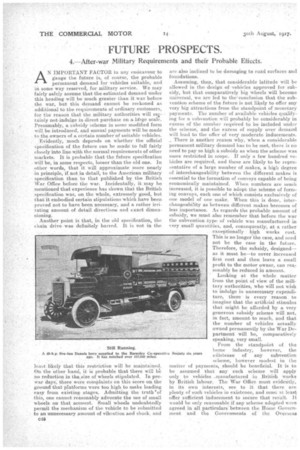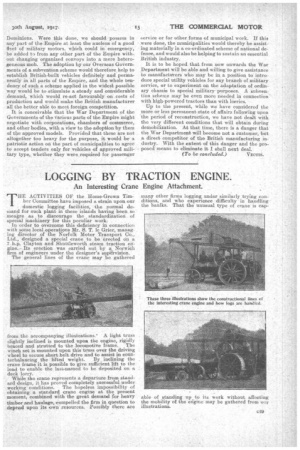FUTURE PROSPECTS.
Page 14

Page 15

If you've noticed an error in this article please click here to report it so we can fix it.
4.—After-war Military Requirements and their Probable Effects.
AN IMPORTANT FACTOR in any endeavour to gauge the future is, of course, the probable permanent demand for vehicles suitable, and in some way reserved, for military service. We may fairly safely assume that the estimated demand under this heading will be much greater than it was before . the war, at this demand cannot be reckoned as additional to the requirements of ordinary customers, for the reason that the military authorities will ceitainly notrindulge in direct purchase on a l.rge scale. Presumably, a subsidy scheme in some modified form will be introduced, and animal payments will be made to the owners of a certain number of suitable vehicles.
Evidently, much depends on whether the official specification of the future can be made' to fall fairly closely into line .withthe normal requirements of other markets. It is probable that the future specification will-be, in some respects, looser than the old one. In other words, that it will approximate more nearly in principle, if, not in detail, to the American military specification than to that publiShed by the British War Office before the war. Incidentally, it.may be mentioned that experience has shown that the British speeification was, on the whole, extremely good, but that it embodied certain stipulations which have been proved not to have been necessary, and a. rather irritating amount of detail directions and exact dimensiOning.
Another point is that, in the -old specification, the chain drive was definitely barred. It is not in the
leastlikely that this restriction will be maintained. On the other hand, it s probable that there will b'e no reduction in the:size of wheels stipulated. In prewar days; there were complaints on this score on the ground' thatPlatforms were too high to make loading easy from existing. ,stages. Admitting the trutlfrof this, one cannot reasonably advocate the use of small wheels on that account. Small wheels undoubtedly permit the mechanism of. the vehicle to be submitted to an unnecessary amount of vibration and shock, and
CU are also inclined to be damaging to road surfaces and foundations.
Assuming, the that considerable latitude will be allowed in the-design of -vehicles. approved for subsidy, but that comparatively big wheels will become universal, we are led to the'conclusion that the subvention scheme of the future is not likely to offer any very big attractions from the standpoint of monetary paynients. The number of available vehicles qualifying for subvention will probably be considerably in excess of the number required to be included under the scheme, and the excess of supply over demaird will load to the offer of very moderate inducements. _ There is another reason why, when a considerable permanent military demand has to be met, there is no need to pay so high a subsidy as when the -scheme was more restricted in scope. If only a few hundred vehicles are required, and these are likely to be representative of a large number of makes, a high degree of interchangeability between the different makes is essential to the formation of convoys capable of being economically maintained. When numbers are much increased, it is possible to adopt the scheme of forming convoys, each one of which consists exclusively of one model of one -make. When this is done, interchangeability as between different makes becomes or less importance. As regards the probable amount of subsidy, we must also remember that before the war the subvention -type of vehicle was manufactured in very small quantities, and, consequently, at a rather exceptionally high works cost. This is no longer the case, and need not be the case in the future. Therefore, the subsidy, designed— as it must be—to cover increased first cost and then leave a small profit to the motor owner, can reasonably be reduced in amount. -
Looking at the whole matter from the point of view of the military authorities, who will not wish to indulge in unnecessary expenditure, there is every reason , to imagine that the artificial stimulus that might be afforded by a very generous subsidy scheme will not, in fact, amount to much, and that the number of vehicles actually owned permanently by the War Department will be, comparatively speaking, very small.
From the standpoint of the home • industry, however, the el•Iistenee of any subvention scheme, however modest in the matter of payments, .should be beneficial. It is to be assturted that any such scheme will apply only to vehicles -manufactured in British works by British labour, The War Office must evidently, in its Own interests, see to it that there are plenty of such vehicles in existence, and must at least offer sufficient inducement to secure that result. It would be only reasonable if any scheme adopted were agreed in all particulars' between the Home. Government -and the Governments of the Overseas
Dominions. Were this done, we should possess in any part of the Empire at least the nucleus of a good fleet of military motors, which could in emergency, be added to from any other part of the Empire without changing organized convoys into a mere heterogeneous mob. The adoption by our Overseas Govern-. merits of a subvention scheme would therefore help to establish British-built vehicles definitely and pernianeatly in all parts of the Empire, and the whole tendency of such a scheme applied in the widest possible way would be to stimulate a steady and considerable demand, which would re-act favourably on. costs of production and would make the British manufacturer all the better able to meet foreign competition.
It is conceivable that the War Department of the Governments of the various parts of the Empire might negotiate with corporations, chambers of commerce, and other bodies, with a view to the adoption by them of the approved models. Provided that these are not altogether too heavy for the purpose, it would be a patriotic action on the part of municipalities to agree to accept tenders only for vehicles of approved military type,. whether they were required for passenger service or for other forms of municipal work. If this were done, the municipalities would thereby be assisting materially in a co-ordinated scheme of national defence, and would also be helping to sustain an essential British industry.
It is to be hoped that from now onwards the War Department will be able and willing to give assistance to manufacturers who may be in a position to introduce special utility vehicles for any branch of military service, sr to experiment on the adaptation of ordinary chassis to special military• purposes. A Subvention scheme may be even more needed in connectionWith high-powered tractors than with lorries.
Up to the present, while we have considered the
more or less permanent state of affairs following upon the period of reconstruction, we have not dealt with the very different conditions that will obtain during demobilization. At that time, there is a danger that the Wax Department will become not a customer, btit a direct competitor of the British manufacturing industry. With the extent of this danger and the proposed means to eliminate it I shall next deal.
(To be concluded.) VECTIS.






















